| | |
 |
Archway. |
St Leonard's Street. This is the third site for this arch. The archway originally belonged to Northumberland House which stood near the Embankment. When that was pulled down, it was then used as the entrance to the garden of Tudor House on the site of Bob's Park. It was moved here in 1998. It was designed by William Kent and dates from the 18th century. (See No. 1. on the Lower Map)
|
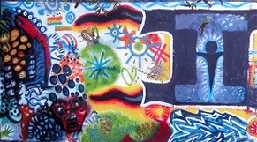 |
Bow Common Mural. |
By the junction of Bow Common Road and Devons Road. This mural has been defaced by graffiti. It was in the fields near this area in 1381 that many people from Essex and Kent gathered in what is known as the Peasant's Revolt and complaining about the Poll Tax. The young Richard II appeared to agree to their demands. At a second meeting the leader Wat Tyler was provoked to violence and was killed by the mayor of London and the revolt collapsed. (See No. 2. in the Upper Map)
|
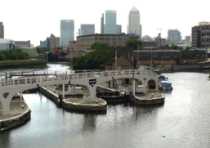 |
Bow Locks. |
Viewed from the bridge in Twelvetrees Cresent. From early times, as the River Lee neared the Thames it, divided into several channels which flowed through marshy areas. The Romans built a ford (Old Ford), Queen Maud built Bow Bridge and in the 14th century the Abbot of Stratford Langthorne Abbey tried unsuccessfully to divert the river to avoid flooding. By the 18th century the river Lee was linked to the canal system and in 1776 the Limehouse Cut (on the right) was dug. At that time the levels of Bow Creek on the left, this Cut and the Lee altered with the tide. The first lock was built in 1850 and reduced the fluctuation in levels in the canals. But a flood in 1928 led to an upgrade to the lock in the 1930s, which stopped this tidal rise. (See No. 3. in the Upper Map)
|
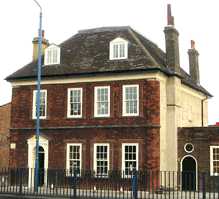 |
Bromley Hall. |
43 Gillender Road, besdide the A 102 Blackwall Tunnel approach road. From the front it appears to date from Queen Anne's time, but it was built c. 1485 in the reign of Henry VII and so is probably the oldest brick-built dwelling house in the London area. Inside the house, some wooden doorways and parts of Tudor wall paintings still survive. In five centuries the house has had a series of prosperous owners who each in turn made major makeovers. Originally, the main entrance was at the present rear, where it faced the river Lea. Much of the brickwork on the present front including the narrow towers at each end is Tudor. Excavations have revealed that the Tudor building rests on 13th century foundations of what was South Bromley manor house. Occupants have included William Cecil, who later as Lord Burghley was Chief Secretary of State to Queen Elizabeth I, and John Blount whose daughter Elizabeth was of one of Henry VIII's mistresses. (See No. 4. in the Upper Map)
|
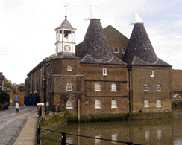 |
The Clock Mill. |
Three Mill Lane. Two of the three mills, which gave the name to the lane, still survive from the 18th century. The Clock Mill dates from 1753. The House Mill directly opposite was built by Daniel Bisson, a Huguenot in 1776. These mills were powered by the tides on the river Lea and had adaptable mechanism which could be driven by both the incoming and outgoing tide. Originally built for grinding corn for flour, they were later used as distilleries. During World War 1, Chaim Weitzman used the House Mill to grind corn and chestnuts to produce essential ingredients of explosives for armaments. (See No. 5. on the Upper Map)
|
 |
Mosaics of the Bromley By Bow Church in the Community. |
On the corner of Bruce Road and St Leonard's Street. The Church has also been called Bruce Road Congregational Church. These mosaics are just a few of the art works on display here, as the building is also used as an arts centre. The four artists were community care people who came to the centre and who each made a part of this long panel. (See No. 6. on the Lower Map)
|
 |
Draper's Almshouses |
At the end of a cul-de-sac off Rainhill Way and behind Bromley Public Hall. This chapel and four almshouses date from 1706, although originally they were just part of a set of twelve, which were started in 1617 due to the generosity of Sir John Jolles. The arms of the Drapers Company adorn the front of the central chapel. (See No. 7. in Upper Map )
|
  |
Flood Markers. |
Just past the Clock Mill there is a passageway with a narrow gage railway track set into it. On the left hand side of this there are three inscribed stones showing flood levels. The bottom stone is almost illegible but the others have a horizontal line and a date. So that we see that on January 7th 1928 the mills were under about three feet of water. Linked with this, there is another stone almost opposite the House Mill, which commemorates the River Lee Flood Relief Act of 1930 which enabled work to be carried out in dredging and widening the waterways and improving the locks and bridges, etc. Note the spelling on this stone which speaks of LEE and not LEA but compare it with the names of Leamouth and Leyton. Some say that LEE must be correct because it is "carved in stone". (See No. 8. in Upper Map )
|
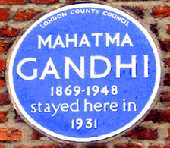 |
Mahatma Gandhi |
Just before World War 1, two sisters Muriel and Doris Lester, inspired by their Christian beliefs, opened a nursery school near here and so allowed mothers to go out to work. In 1928, they opened Kingsley Hall (named after their brother who died young) and established it as a social centre. They were inspired by their Christian faith to ameliorate the lives of the poor in the East End. The sisters stood for Peace, Temperance and women's rights, supporting the suffragette movement. Kingsley Hall was intended to be a "Teetotal Public House". In 1931, Mahatma Gandhi stayed there, while attending the fruitless Whitehall Conference discussing Indian independence. Near to the roof garden, the little room in which he stayed has been preserved. (See No. 9. on the Lower Map)
 Kingsley Hall Kingsley Hall
|
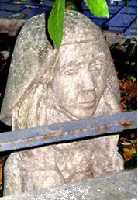 |
Hear No Evil. |
Bruce Road. Amongst the greenery in front of Bromley by Bow Church in the Community. The title given here is not the correct one and only reflects the present position of the sculpture. This is a portrayal of a nun with her fingers in her ears trying to keep out the sounds of the workday world around her. (See No. 10. on the Lower Map)
Sculptor: Ross Law.
|
 |
The House Mill. |
Three Mill Island. DSB are the initials of Daniel Bisson, the Huguenot who built the mill in 1776. However the present building only dates back to 1802 because it had to be rebuilt following a fire. This crest was rescued from the ruins. (See No. 11. on the Upper Map) (See also the Clock Mill.)
 House Mill House Mill
|
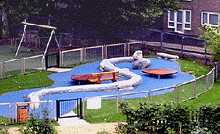 |
"Lord Mayor's Dragon." |
Bob's Park, St Leonard's Street. This child-friendly scaled serpent or dragon in the children's play area has a small trough down it's back designed to fill with water after rain. (See also Animal Seat by the same sculptress.) (See No. 12. on the Lower Map)
Artist: Paula Haughney. (See also By the same Sculptress "Exotic Birds" and 6 other works, "Dockers' Memories" , " Heron", "The Passenger" , " Ram and Magpie", and "Smiling Beast" )
|
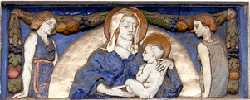 |
Madonna and Child. |
Children's House, Bruce Road. This Nursery school was founded by Muriel and Doris Lester in 1912 in connection with their work at Kingsley Hall; but this building was opened in 1923 by the author H.G.Wells. This coloured sculpture of Mary and Jesus is over the main entrance leading from the playground. (See No. 13. on the Upper Map)
Sculptor: Gilbert Bayes. (See also St Hubert's Deer by the same artist.)
|
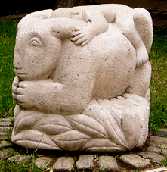 |
"The Passenger." |
St Leonard's Street. Inside the courtyard of the Bromley by Bow Health Centre and visible through the Archway from the street outside. The statue was commissioned to remember the life and work of Lord Ennals. The artist worked on this just after the birth of her daughter. Since then she has done two more on the same theme. Other works by the same sculptress, who is the resident artist here, are featured in near-by Bob's Park. (See No. 14. on the Lower Map)
Artist: Paula Haughney. (See also By the same Sculptress "Exotic Birds" and 6 other works, "Dockers' Memories", "Heron", "Lord Mayor's Dragon", "Ram and Magpie", and "Smiling Beast" )
|
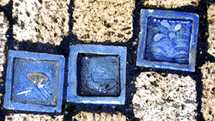 |
Aquatic Path. |
Bob's Park, St Leonard's Street. The path meanders through the park like a stream and the cobbled path has set into it a number of blue glass squares with pictures of animals or flora that live in water. From left to right are shown a fish poking its head out of water, a second fish swimming, and a plant. (See No. 15. on the Lower Map)
Designer: Sheenagh McKinlay. Date 1997.
|
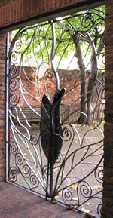 |
Peace Gateway. |
Powis Road. This is the entrance into Kingsley Hall from the Peace Garden and can be seen from the road through the railings. For the Lester sisters, who founded Kingsley Hall, working for peace was a very important part of their lives. (See No. 16. on the Lower Map)
|
 |
The Peace Garden. |
Powis Road in the garden next to Kingsley Hall. The central sculpture is placed in the middle of a small pond which probably accounts for the attractive railings with a fish motif which surround the pond. This is visible through the outer railings from the pavement outside. (See No. 17. on the Lower Map)
|
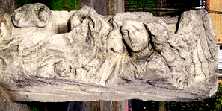 |
"Parallels in Time" |
In the park at the junction of Devons Road and Reeves Road. One of three pieces of masonry forming a group. The stones were found in a pile in the railway yard that once occupied the site of this park. The three have been set up on end as small parallel pillars. The title also reflects the fact that the stones were rescued and reused. As this stone shows a winged angel, it was probably part of a church. It might have come from St Andrew's Church which once stood near here and gave its name to the partially closed hospital on the other side of Devons Road. (See No. 18. on the Upper Map)
Artist: Lucy Smith. Date: 1994.
|
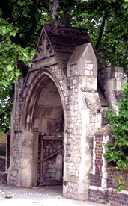 |
St Leonard's Church. |
St Leonard's Street. The Gateway to St Leonard's
churchyard. The 19th century church was destroyed in World War II and this memorial gateway
and the little garden behind are all that remain, following the construction of the A102. The name
of St Leonard's was originally used by a nunnery on this site founded about 1120. The gateway
was erected in memory of George Augustus Mayo How, Rural Dean of Stepney, 1840-1893.
Some fragments of gravestones can be seen in the area beyond the gate, which is now called St
Leonard's Adventurous Playspace. St Leonard's is also remembered in the name of Priory Street,
nearby. (See No. 19. on the
Upper Map)
|
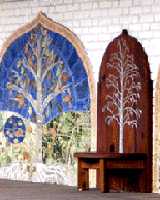 |
School Mural. |
The Old Palace Primary School in St Leonard's Street. The picture shows Autumn, one of the four seasons illustrated. The Old Palace was the name of a large house which stood here from 1606 to 1894. The house had richly decorated interiors. Following a public outcry against its demolition by Charles Ashbee, some of its elaborate plaster panelling is now preserved in The Victoria & Albert Museum. (See No. 20. on the Upper Map)
|
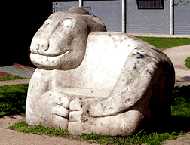 |
"Smiling Beast." |
Bromley By Bow Gardens, St Leonard's Street. Seat in the shape of a large smiling animal. One of three artworks in the park, which are clearly designed to appeal to children. The park is also called Bob's Park, named after Robert Grenfield, the gardener who cared for this park for many years. The second seat is in the shape of a bird. The idea behind these was that children should sit on these and feel themselves surrounded by nature in the shape of the creature supporting them and the marine life embedded in the Aquatic Path. (See also the Serpent and The Passenger by the same sculptress.) (For the Animal Seat See No. 21. in Lower Map )
Artist: Paula Haughney. . (See also By the same Sculptress "Exotic Birds" and 6 other works, "Dockers' Memories", "Heron", "Lord Mayor's Dragon", "The Passenger"and " Ram and Magpie" )
|
 |
The Widow's Son. |
Devons Road almost opposite Campbell Road. Hanging over the bar in this pub is a net filled with old hot cross buns, to which one is added each year. The widow who ran this pub in the early nineteenth century had a son who was a sailor. Each year she made a bun for him. But one year he failed to return for his bun. In the hope that he was still alive, she would bake his bun and add it to the collection. Successive landlords have continued the practice faithfully to the current time. (See No. 22. on the Upper Map)
|
 TO READ NAME AND CLICK FOR PHOTO & EXPLANATION.
TO READ NAME AND CLICK FOR PHOTO & EXPLANATION.






















